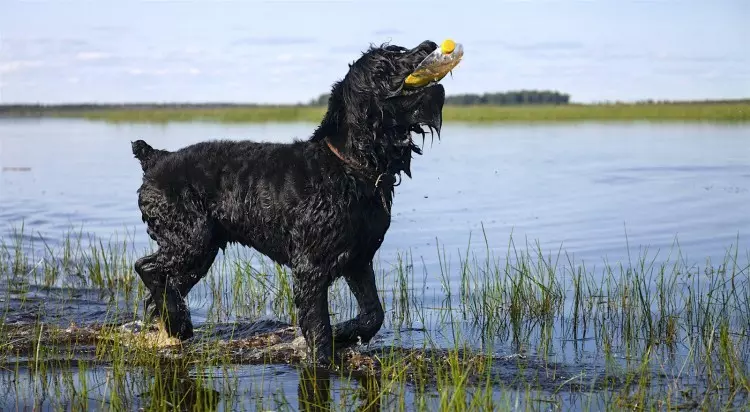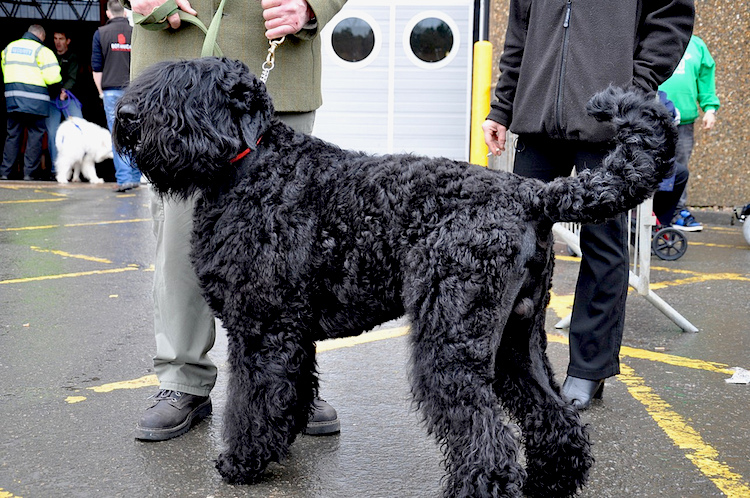
Working
80–130 lbs.
26–30 in.
10–12 years
1. Key Characteristics
The Black Russian Terrier, or BRT, is a large, powerful dog with a large bone structure and muscular build. These dogs are not what comes to mind when thinking about terriers.
The BRT’s eyes are oval-shaped and medium-sized, set far apart and feature black rims. The ears are medium-sized, triangular and set high on the head. They hang down to the cheek area and have rounded tips. The feet are large and round with black nails. The tail is thick and set high in a rare sickle shape; it may be cropped for working dogs.
The waterproof double-coat features a coarse outer coat and a soft undercoat. It is moderately wavy, falls over the eyes and is longer on the face, resembling a beard. The only acceptable color for conformation is black, although gray hairs are allowed.
2. Where They Came From
In the 1930s, the Black Russian Terrier was created by the Russian military, which crossed multiple breeds to obtain a large, reliable and trainable dog who could endure harsh winters. About 17–20 different dog breeds were used to develop the BRT, including the giant schnauzer, Airedale Terrier, Rottweiler and Newfoundland, among others.
The dogs appeared in the United States in the 1980s, and the BRT was added to the American Kennel Club’s Foundation Stock Service in 1996. It was moved to the Miscellaneous Class in 2001 and finally to the Working Group in 2004.

3. How Friendly Are They?
BRTs can be intimidating and dominating. They require a strong leader and trainer. They are reliable, powerful, intelligent, sensitive dogs who can also be stubborn. They are protective of family members and indifferent to or wary of strangers.
This breed is a working dog first and a companion animal second. These dogs must be socialized and trained extensively, especially within the first 2 years. All family members should participate in the training so each can be seen as a leader to the dog. Otherwise, it’s not uncommon for a BRT to obey one person but try to dominate another family member.
BRTs sometimes snore and drool. They love kids but can knock over young children unintentionally because of their large size. They do well with other cats and dogs if properly socialized or raised with them, although it is not recommended to have 2 male BRTs in the same household (they may try to dominate each other and fight).
4. Is This the Right Dog for You?
Exercise Needs
HIGH: The BRT has strong stamina and endurance, and needs daily exercise. Most enjoy water and snow, and are ideal for colder climates. They can live in warmer climates, but keep them cool during hot months.
They are inactive indoors — meaning they can live in apartments with regular outings for exercise. They may suffer from separation anxiety and do not do well when kenneled or crated for long times. This dog must live indoors with the family.
Grooming Needs
MEDIUM: Regular brushing during the week is needed to keep the coat in top shape. The coat should be trimmed throughout the year.
Professional grooming every 6 weeks is recommended because the hair can grow as long as 6 inches. You need to trim the hair around the eyes, mouth and ears. Remove or trim the hair inside the ears and between the paw pads.
If you maintain regular brushing and trimming, the BRT will shed minimally, unless it’s the time of year when the undercoat sheds heavily. The nails are susceptible to cracking, so cut them when necessary. Brush the teeth and clean the ears as part of your grooming routine.
Health Problems
LOW: BRTs are healthy dogs. Notable health conditions for the breed include:
- Juvenile laryngeal paralysis & polyneuropathy (JLPP)
- Uric acid stones (ongoing genetic research is being performed)
- Hip dysplasia
- Elbow dysplasia
- Ear infections or inflammation
Watch this young girl train a very willing Black Russian Terrier:

5. Where to Adopt One
BRTs can be hard to find. The Black Russian Terrier Club of America website does not list available rescue dogs for adoption but accepts names to be added to a waiting list. Contact local rescues and shelters to see if a purebred BRT is available.
If you contact a breeder, be sure to meet the dog’s parents and spend time ensuring that the temperament of the dogs is stable and not aggressive.








